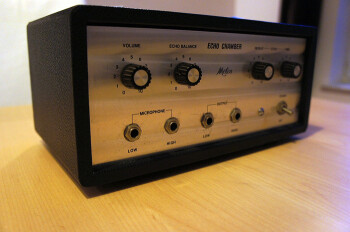Today we'll look into chamber and ambience reverbs.
Into the chamber

(photo by Nepz)
Chamber reverbs emulate yet another old concept used in the studio. The principle behind them is quite simple: You place one or several speakers in a room where sound is reproduced and record the reverberation with one or several mics judiciously placed in the same room. The type of room is crucial to the end result. It can also be a stairwell or a hallway or a room especially conceived to that end, like the famous Abbey Road echo chamber. In terms of sound, the range is pretty wide and depends on the size ─ they are usually small to mid-sized ─ and, especially, on the materials of the room (wood, glass, concrete, etc.). So, for instance, a small, wooden chamber would be the perfect match for a chamber ensemble, while a stairwell can provide a Led Zeppelin “When the Levee Breaks”-like sound.
Chamber reverbs can be used on lots of different elements: percussion instruments, small orchestras, synthetic sounds, vocals, etc. You should always bear in mind, however, that due to the concept itself, the sound produced isn’t 100% realistic. In fact, the recording of the reverberation of a room “excited” by a speaker will never be able to replicate the complexity and sophistication that a musician would produce in the same environment. Hence, the use of this type of reverb is limited to instrume
nts and/or productions that require a sense of space rather than a well-defined localization.
Soaking up the ambience
As the name implies, ambience reverbs aim to create the illusion of a room’s acoustic ambience. What I mean by this is not a precise or natural spatial notion, but rather a certain sonic cohesion produced by instruments played in the same place. Ambiences usually very short and discrete, ideal to get the famous “glue” effect on the entire mix by wisely controlling the send of each element towards the reverb bus or buses. They are also commonly used on track groups, like an entire drum kit, for instance. On the other hand, this type of algorithm is seldom used on a single instrument, unlike the previous reverb types I’ve mentioned. Also note that ambient reverbs usually make a perfect match for pure synthetic sounds. In fact, they allow you to make synthetic sounds more “lively” by adding that famous “glue” effect that will make them blend in with the rest of the acoustic elements without bogging them down nor sending them to the back of the mix.
Finally, this type of reverb can often be replaced with a very short delay. Why chose one over the other? Well, it’s just a matter of taste and habit. Personally, I tend to use delays since that’s the way I’ve always done it and it’s part of my workflow. But to be true, I know I could get the same results with an ambience reverb, although it would take me some time to get used to it.
In the next and final installment dealing with reverb types, I’ll tackle the main category among all of them, namely room reverb.
